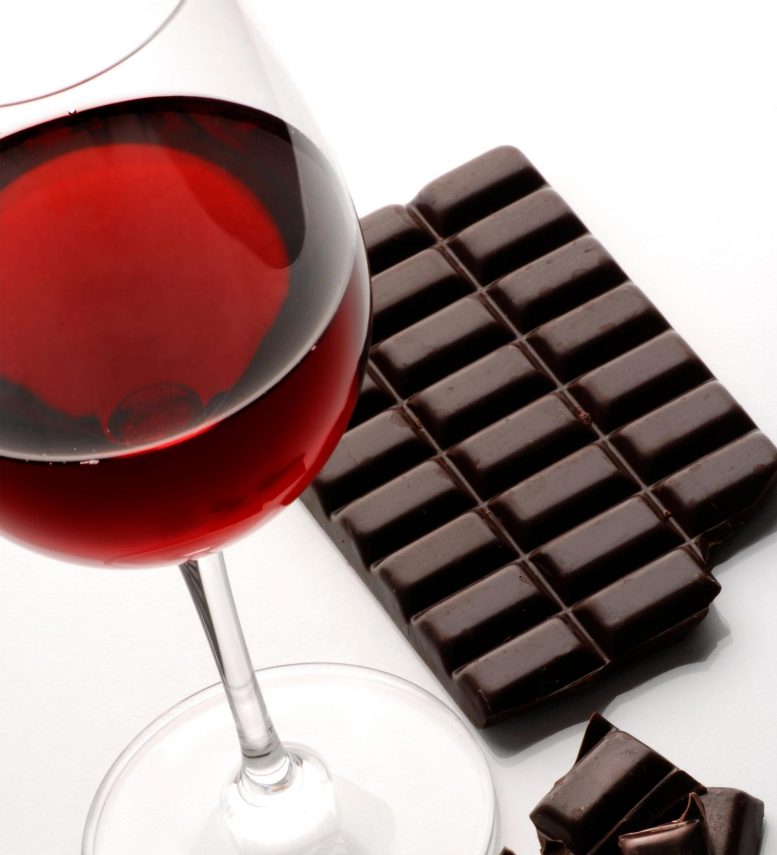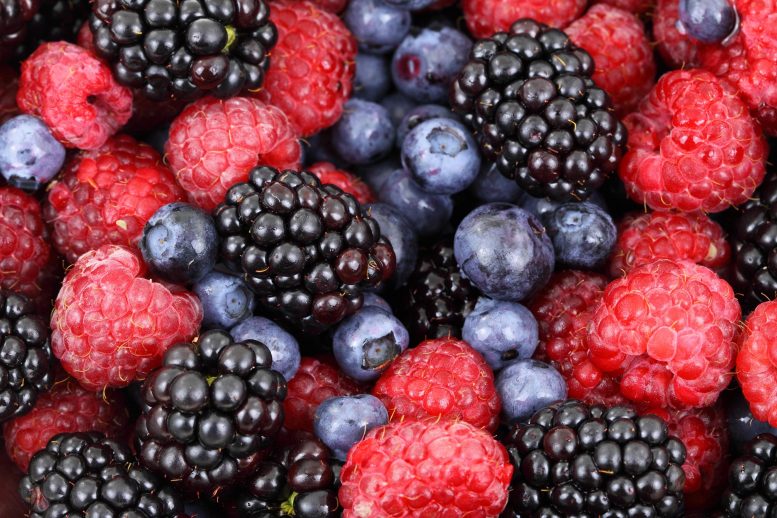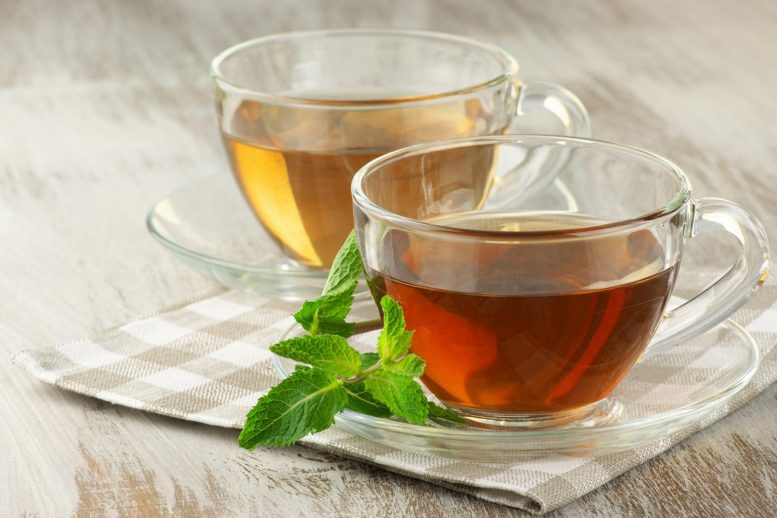
Wine and dark chocolate are rich in flavonoids.
- Flavonoids found in plants and plant foods such as berries, apples, tea, wine and dark chocolate are known to offer health benefits, including some protective effects on the cardiovascular system.
- A study of over 900 adults in Germany evaluated the quantity and frequency of eating flavonoid-rich foods and measured bacteria in the gut microbiome to determine if there was an association with blood pressure levels.
- Researchers determined the participants who consumed higher levels of berries, apples, pears and wine had lower systolic blood pressure levels, which was explained in part by bacteria in their gut microbiome.
Flavonoid-rich foods, including berries, apples, pears and wine, appear to have a positive effect on blood pressure levels, an association that is partially explained by characteristics of the gut microbiome, according to new research published today in Hypertension, an American Heart Association journal.
“Our gut microbiome plays a key role in metabolizing flavonoids to enhance their cardioprotective effects, and this study provides evidence to suggest these blood pressure-lowering effects are achievable with simple changes to the daily diet,” said lead investigator of the study Aedín Cassidy, Ph.D., chair and professor in nutrition and preventive medicine at the Institute for Global Food Security at Queen’s University in Belfast, Northern Ireland.

Blackberries blueberries, and raspberries contain flavonoids.
Flavonoids are compounds found naturally in fruits, vegetables and plant-based foods such as tea, chocolate and wine, and have been shown in previous research to offer a variety of health benefits to the body. Flavonoids are broken down by the body’s gut microbiome—the bacteria found in the digestive tract. Recent studies found a link between gut microbiota, the microorganisms in the human digestive tract, and cardiovascular disease (CVD), which is the leading cause of death worldwide. Gut microbiota is highly variable between individuals, and there are reported differences in gut microbial compositions among people with and without CVD.
With increased research suggesting flavonoids may reduce heart disease risk, this study assessed the role of the gut microbiome on the process. Researchers examined the association between eating flavonoid-rich foods with blood pressure and gut microbiome diversity. The study also investigated how much variance within the gut microbiome could explain the association between intake of flavonoid-rich foods and blood pressure.

Tea is rich in flavonoids.
A group of 904 adults between the ages of 25 and 82, 57% men from Germany’s PopGen biobank were recruited for this study. (The PopGen biobank includes participants from a network of seven biobanks in Northern Germany.) Researchers evaluated the participants’ food intake, gut microbiome, and blood pressure levels together with other clinical and molecular phenotyping at regular follow-up examinations.
Participants’ intake of flavonoid-rich foods during the previous year was calculated from a self-reported food questionnaire detailing the frequency and quantity eaten of 112 foods. Flavonoid values were assigned to foods according to United States Department of Agriculture data on flavonoid content in food.
Gut microbiome for participants was assessed by fecal bacterial DNA extracted from stool samples. After an overnight fast, participants’ blood pressure levels were measured three times in three-minute intervals after an initial five-minute rest period. Researchers also collected participants’ lifestyle information, including sex, age, smoking status, medication use, and physical activity, as well as family history of coronary artery disease, the number of daily calories and fiber consumed, and each participant’s height and weight were measured to calculate BMI (body mass index).
The analysis of regular flavonoid intake with gut microbiome and blood pressure levels found:
- Study participants who had the highest intake of flavonoid-rich foods, including berries, red wine, apples and pears, had lower systolic blood pressure levels, as well as greater diversity in their gut microbiome than the participants who consumed the lowest levels of flavonoid-rich foods.
- Up to 15.2% of the association between flavonoid-rich foods and systolic blood pressure could be explained by the diversity found in participants’ gut microbiome.
- Eating 1.6 servings of berries per day (one serving equals 80 grams, or 1 cup) was associated with an average reduction in systolic blood pressure levels of 4.1 mm Hg, and about 12% of the association was explained by gut microbiome factors.
- Drinking 2.8 glasses (125 ml of wine per glass) of red wine a week was associated with an average of 3.7 mm Hg lower systolic blood pressure level, of which 15% could be explained by the gut microbiome.
“Our findings indicate future trials should look at participants according to metabolic profile in order to more accurately study the roles of metabolism and the gut microbiome in regulating the effects of flavonoids on blood pressure,” said Cassidy. “A better understanding of the highly individual variability of flavonoid metabolism could very well explain why some people have greater cardiovascular protection benefits from flavonoid-rich foods than others.”
While this study suggests potential benefits to consuming red wine, the American Heart Association suggests that if you don’t drink alcohol already, you shouldn’t start. If you do drink, talk with your doctor about the benefits and risks of consuming alcohol in moderation. According to a statement on dietary health by the American Heart Association, alcohol intake can be a component of a healthy diet if consumed in moderation (no more than one alcoholic drink per day for women and 2 alcohol drinks per day for men) and only by nonpregnant women and adults when there is no risk to existing health conditions, medication-alcohol interaction, or personal safety and work situations.
The authors note that participants for the study were from the general population, and the participants were unaware of the hypothesis. However, residual or unmeasured confounding factors (such as other health conditions or genetics) can lead to bias, thus these findings cannot prove a direct cause and effect, although the researchers did conduct a detailed adjustment in their analyses for a wide range of diet and lifestyle factors. The authors noted the focus of this study was on specific foods rich in flavonoids, not all food and beverages with flavonoids.
Reference: “Microbial Diversity and Abundance of Parabacteroides Mediate the Associations Between Higher Intake of Flavonoid-Rich Foods and Lower Blood Pressure” by Amy Jennings, Manja Koch, Corinna Bang, Andre Franke, Wolfgang Lieb and Aedín Cassidy, 23 August 2021, Hypertension.
DOI: 10.1161/HYPERTENSIONAHA.121.17441
Co-authors are first author Amy Jennings, Ph.D.; Manja Koch, Ph.D.; Corinna Bang, Ph.D.; Andre Franke, Ph.D.; and Wolfgang Lieb, M.D., M.Sc. The authors’ disclosures are listed in the manuscript.
The research was funded by grants from the German Research Foundation and the German Federal Ministry of Education and Research. The PopGen biobank is supported by the German Federal Ministry of Education and Research and the Medical Faculty of the University of Kiel.









Be the first to comment on "Flavonoid-Rich Foods – Such As Apples, Berries, Dark Chocolate and Wine – Improve Blood Pressure Levels"